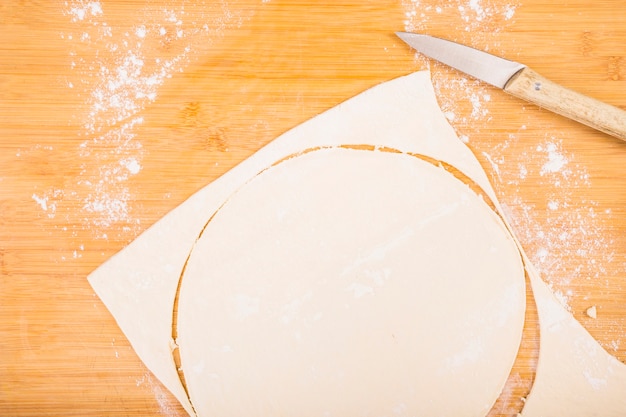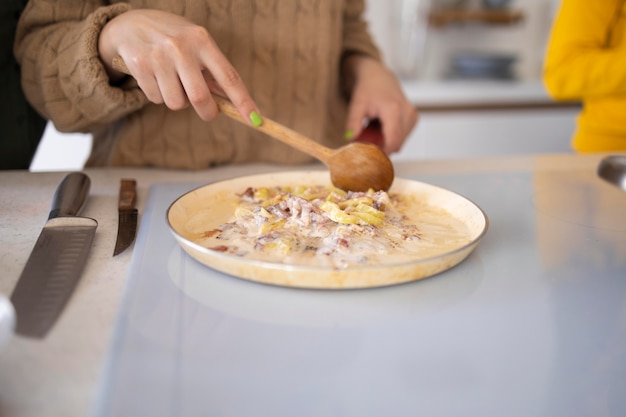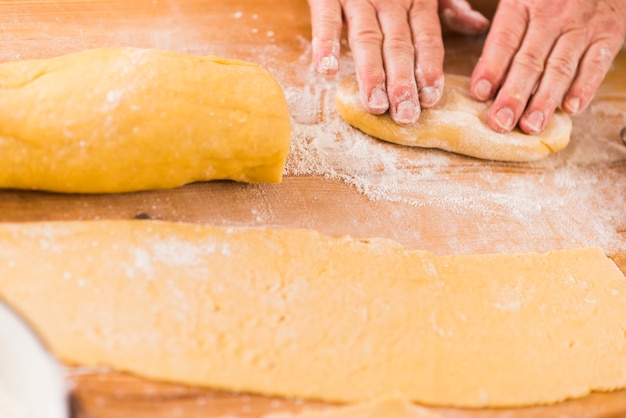The aroma of a freshly baked pie, its golden-brown crust shimmering under the oven light, is a sensory experience that transcends mere taste. It’s a symphony of textures, a dance of flavours, and a testament to the magic of baking. For me, a pie is more than just a dessert; it’s a canvas for creativity, a chance to experiment with textures and flavours, and to share a taste of home with loved ones. But the heart of any good pie lies in its crust – that delicate, flaky shell that holds together the sweet or savoury treasures within.
I’ve spent countless hours in the kitchen, experimenting with different pie crust recipes, learning the secrets to crafting a perfect crust that’s not only visually appealing but also melts in your mouth with every bite. It’s a journey of trial and error, of discovering the subtle nuances of ingredients and techniques that elevate a humble pie crust into a culinary masterpiece. And in this journey, I’ve uncovered some invaluable tips and tricks that I’m eager to share with you.
So, if you’re ready to embark on your own pie crust adventure, let’s delve into the world of flaky goodness, exploring the essential ingredients, the delicate art of handling dough, and the secrets to achieving that perfect golden brown crust.
(Part 1) The Ingredients: A Foundation for Flaky Goodness

The key to a truly spectacular pie crust lies in choosing the right ingredients and handling them with care. Think of it as building a foundation for a magnificent structure. Each element plays a vital role in creating that signature flaky texture and delicate flavour that makes a pie crust so irresistible.
The Flour: Your Crust’s Backbone
Flour is the backbone of your pie crust. It provides structure, ensuring your crust holds its shape and doesn’t crumble into a pile of crumbs. While all-purpose flour is a reliable option, I often prefer a blend of all-purpose and cake flour for an extra-flaky, tender result. Cake flour’s lower protein content translates into a softer, more delicate texture, enhancing the overall tenderness of the crust.
- All-purpose flour: The workhorse of baking, all-purpose flour delivers a balance of structure and chewiness. It’s a reliable choice for most pie crusts, providing a sturdy base for your culinary creation.
- Cake flour: This delicate flour is perfect for adding a touch of softness and finesse to your crust. Its lower protein content ensures a tender texture that melts in your mouth.
- Bread flour: With its higher protein content, bread flour delivers a chewier crust. If you prefer a sturdier bite, consider using bread flour, but it might be a bit too chewy for some tastes.
Remember, the key is to sift the flour – this removes any lumps and ensures that the ingredients are evenly distributed, leading to a smoother dough. And, always use cold flour. Cold butter and cold flour are the secret to that coveted flaky, tender crust.
The Butter: A Symphony of Flakes
Now, onto the butter, the star of the pie crust show! The quality of your butter is paramount. I always opt for unsalted butter, allowing me to control the final flavour profile. And, it must be cold – think just out of the fridge cold. Cold butter is essential for creating those beautiful, flaky layers that make a pie crust sing.
When incorporating the butter, I use a pastry blender. This method ensures that the butter is cut into small pieces, creating those lovely flakes. The goal is to achieve a mixture that resembles coarse crumbs, where the butter is evenly distributed throughout the flour.
The Liquid: Bringing the Dough Together
Finally, we have the liquid, usually ice-cold water. Here’s where precision is crucial. You only want to add enough water to bind the dough together, creating a cohesive mass. Too much water will result in a tough crust. Some recipes also call for a touch of vinegar, which helps inhibit gluten development, leading to a more tender crust.
(Part 2) The Dough: Mastering the Art of Handling

The dough is where the magic truly begins. It’s a delicate balance of ingredients, and the way you handle it plays a crucial role in the final outcome.
Kneading, or Lack Thereof: A Gentle Touch
This is where many bakers stumble. Overworking the dough is a common mistake, leading to a tough crust. The key is to handle the dough gently. I usually knead just enough to bring the dough together, then shape it into a disc. Wrap it tightly in plastic wrap and refrigerate it for at least 30 minutes.
The Rest: A Time for Patience
This chilling time is crucial. It allows the butter to solidify, ensuring those beautiful flakes form during baking. While the dough rests, preheat your oven. It’s best to have the oven at the right temperature before you start rolling out the crust.
(Part 3) Rolling and Shaping: A Symphony of Flakes

This stage is both enjoyable and crucial. A gentle hand is required to transform the chilled dough into the perfect pie crust shape.
The Rolling: A Delicate Dance
I prefer to roll out the dough on a lightly floured surface. A gentle touch is essential. Avoid over-rolling, which can make the dough tough. Use a rolling pin to roll the dough into a circle that’s slightly larger than your pie pan. Remember to keep the edges of the dough thin to prevent them from burning.
The Shaping: A Personal Touch
After rolling, carefully transfer the dough to the pie pan. Gently press the dough into the pan, ensuring it fits snugly. To prevent the edges from shrinking back during baking, I crimp them by pinching them between my fingers. This creates a beautiful, decorative edge and helps maintain the integrity of the crust.
(Part 4) The Baking: A Golden Transformation
Finally, the moment of truth! The baking process is where the magic truly unfolds, transforming the dough into that irresistible golden-brown masterpiece.
The Pre-Baking: A Foundation for Success
blind baking, or pre-baking the crust without the filling, is a crucial step in achieving a perfect pie crust. This prevents a soggy bottom and helps the crust maintain its shape during the baking process. It’s a technique that takes a little extra time, but the results are well worth the effort.
I usually line the crust with parchment paper and fill it with pie weights or dried beans. This helps to keep the crust from bubbling up during baking, ensuring that it bakes evenly and doesn’t lose its shape. It’s a technique that ensures a beautiful, crisp crust that stands up to even the most decadent fillings.
The Filling: Bringing It All Together
After the crust is pre-baked, it’s time to add the filling. This is where your creativity can truly shine. From classic fruit pies to savory meat pies, the possibilities are endless.
The Baking Time: A Balancing Act
The baking time will vary depending on the type of filling and the size of your pie. For a classic fruit pie, it’s usually around 15-20 minutes at 350°F. But it’s always best to check the crust for doneness. You know it’s ready when it’s golden brown and set. To test it, gently press the centre of the crust. It should spring back.
(Part 5) Variations on a Theme: Exploring the Crust’s Potential
The beauty of a pie crust lies in its versatility. It can be adapted to accommodate a wide range of fillings, from sweet to savory, allowing you to explore a world of culinary creativity.
The Sweet Side: Fruit Pies, Cream Pies, and More
For sweet pies, I have a particular fondness for classic apple pie, with its warm, cinnamon-spiced filling that evokes a sense of comfort and nostalgia. Or, a blueberry pie, bursting with fresh berries and a touch of lemon, a symphony of summer flavours. A custard pie, smooth and creamy, is another classic favourite, its velvety texture a delightful contrast to the crisp crust.
The Savoury Side: A World of Possibilities
Savoury pies offer a delicious way to use up leftover vegetables or meat. A classic chicken pot pie with a creamy filling is always a crowd-pleaser, while a hearty beef and mushroom pie provides a satisfying and warming meal. My personal favourite is a spinach and feta pie, packed with flavour and a touch of Mediterranean flair.
(Part 6) Troubleshooting: Common Challenges and Solutions
Even the most experienced bakers face challenges in the kitchen. With pie crusts, there are some common pitfalls that can be easily overcome with a few simple tips.
The Cracked Crust: A Common Problem
One of the most common problems with pie crusts is cracking. This can happen when the dough is over-rolled or not baked long enough. To prevent cracking, make sure to bake the crust for the recommended time and avoid overworking the dough. A gentle touch is key.
The Soggy Bottom: A Culinary Nightmare
Another common problem is a soggy bottom. This can happen when the filling is too wet or the crust isn’t pre-baked properly. To avoid a soggy bottom, always pre-bake the crust and use a filling that isn’t overly watery.
The Tough Crust: A Matter of Technique
A tough crust is often a sign of over-kneading or over-baking. To prevent a tough crust, knead the dough gently and bake it for the recommended time. Pay attention to the heat and don’t let the crust burn.
(Part 7) Tips and Tricks: Mastering the Art of Pie Crust Perfection
With a few key tips and tricks, you can elevate your pie crust game to new heights. Here are some of my tried-and-true techniques that have helped me achieve consistent, flaky, and delicious results.
The Importance of Cold Ingredients
This is the golden rule of pie crust baking: cold ingredients are key to a flaky crust. I always keep my butter and flour in the fridge until I’m ready to use them. This ensures that the butter doesn’t melt prematurely, leading to a tough crust.
The Power of a Pastry Blender
A pastry blender is my go-to tool for cutting in the butter. It’s a lot easier than using a knife and it helps to create the perfect crumbly texture. The goal is to have the butter evenly distributed throughout the flour, creating those tiny flakes that make a pie crust so delectable.
The Art of Blind Baking
Blind baking is essential for a crisp crust. I always pre-bake my crust, even for pies with fillings that don’t need it, just to make sure it’s golden brown and cooked through. This ensures a sturdy base that can handle any filling, preventing that dreaded soggy bottom.
The Magic of Patience
Patience is key when it comes to baking a pie crust. Don’t rush the process – let the dough chill, let the crust bake slowly, and let the flavours develop. This allows the ingredients to meld, the flavours to deepen, and the crust to achieve that perfect texture.
(Part 8) pie crust variations: Exploring the World of Flavour
A classic pie crust is delicious on its own, but there’s always room for a little creativity. Here are some variations that can add a touch of excitement to your pie-baking repertoire.
Herbs and Spices: Adding Depth to Your Crust
You can add a touch of flavour to your pie crust by incorporating herbs or spices. A pinch of rosemary or thyme is delicious in savoury pies, adding a warm, earthy note. Cinnamon or nutmeg, on the other hand, are perfect for sweet pies, creating a comforting aroma and flavour that’s both familiar and inviting.
Cheese: A Cheesy Twist
For a cheesy crust, add a few tablespoons of grated cheese to your dough. Parmesan or cheddar work well, but you can use any kind of cheese you like. The cheese adds a savoury dimension and a hint of saltiness, complementing a wide range of fillings.
Nuts: A Crunchy Delight
To add a crunchy texture, incorporate chopped nuts into your dough. Pecans, almonds, and walnuts are all good choices, adding a delightful textural contrast and a nutty flavour.
(Part 9) Serving Your Pie: A Moment of Glory
After all that effort, it’s time to enjoy your creation! I love to serve my pies warm, with a scoop of vanilla ice cream or a dollop of whipped cream. The contrast of hot and cold, sweet and creamy, creates a symphony of flavours that is simply irresistible.
The Presentation: A Feast for the Eyes
Presentation is everything! I like to arrange my pies on a beautiful serving platter with a sprig of fresh herbs or a scattering of berries. It’s a simple touch that adds a touch of elegance and elevates the pie to a culinary masterpiece.
FAQs
1. How long do I need to chill the dough?
Ideally, you should chill the dough for at least 30 minutes. If you have time, chilling it for longer (up to 2 hours) will give you a flakier crust. The chilling time allows the butter to solidify, ensuring that it doesn’t melt during rolling and baking, leading to those beautiful, flaky layers.
2. How do I know when the crust is done?
The crust should be golden brown and set. You can also test it by gently pressing the centre of the crust. It should spring back. If the crust is still soft, it needs a little more time in the oven.
3. What do I do if my crust is too crumbly?
If your crust is too crumbly, it’s likely because you didn’t use enough liquid. You can add a tablespoon of water at a time until the dough comes together. But, be careful not to add too much water, as this can result in a tough crust.
4. What if my crust shrinks back during baking?
If your crust shrinks back during baking, it’s likely because it wasn’t chilled long enough. Chill the dough for at least 30 minutes before rolling and baking. This allows the gluten in the flour to relax, preventing the crust from shrinking back.
5. How can I prevent a soggy bottom?
To prevent a soggy bottom, pre-bake your crust. Line the crust with parchment paper, fill it with pie weights or dried beans, and bake it for 10-15 minutes. This pre-baking process helps to set the crust, preventing it from becoming soggy when the filling is added.
Conclusion: A Baking Journey Worth Taking
Baking a pie crust is a journey, but it’s a journey that’s filled with delicious rewards. It’s about embracing the process, experimenting with different flavours, and celebrating the simple joys of baking. So, the next time you’re craving a delicious pie, don’t be afraid to give it a go. With a little patience and practice, you’ll be baking golden brown, flaky crusts that are worthy of any celebration.
Everyone is watching

Corn on the Cob: The Ultimate Guide to Perfectly Cooked Ears
Healthy MealsAh, corn on the cob. Just the name evokes images of sunny days, barbecues, and that sweet, juicy flavour that ...

Perfect Pork Roast Oven Cooking Time: A Guide to Delicious Results
Healthy MealsThere's something truly satisfying about a perfectly roasted pork. The aroma alone is enough to make your mout...

Scallops: The Ultimate Guide to Perfect Cooking
Healthy MealsAh, scallops. Those delicate, sweet, and utterly delicious morsels of the sea. They hold a special place in my...

Ham Cooking Time: How Long to Bake, Smoke, or Boil a Delicious Ham
Healthy MealsAh, ham. It's a classic, isn't it? A real crowd-pleaser, especially around holidays. And when done right, it'...

Spaghetti Squash: The Ultimate Guide to Cooking and Serving
Healthy MealsRemember that time you saw spaghetti squash at the supermarket, looking all bumpy and strange, and thought, "W...
